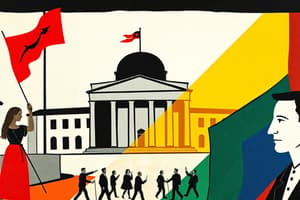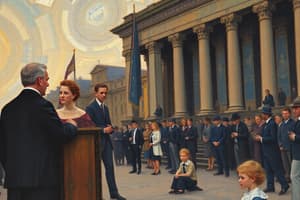Podcast
Questions and Answers
What year was the Weimar Republic established?
What year was the Weimar Republic established?
- 1919 (correct)
- 1918
- 1921
- 1920
Which system of representation was included in the Weimar Constitution?
Which system of representation was included in the Weimar Constitution?
- Two-party system
- Proportional representation (correct)
- Majority representation
- Winner-takes-all
Who held significant powers under the Weimar Republic's political structure?
Who held significant powers under the Weimar Republic's political structure?
- President (correct)
- Reichstag members
- Chancellor
- Local governors
What economic crisis occurred between 1921 and 1923 in the Weimar Republic?
What economic crisis occurred between 1921 and 1923 in the Weimar Republic?
Which political parties gained prominence during the instability of the Weimar Republic?
Which political parties gained prominence during the instability of the Weimar Republic?
In what year did Hitler become Chancellor, marking the end of the Weimar Republic?
In what year did Hitler become Chancellor, marking the end of the Weimar Republic?
Which notable artistic movement emerged during the Weimar Republic?
Which notable artistic movement emerged during the Weimar Republic?
What is a common view of the Weimar Republic's legacy?
What is a common view of the Weimar Republic's legacy?
Flashcards are hidden until you start studying
Study Notes
Overview of the Weimar Republic
- Established: 1919, following Germany's defeat in World War I.
- Named after Weimar, where the constitutional assembly took place.
- Form of government: Democratic republic.
Key Features
- Constitution: Adopted in 1919; included a bill of rights and proportional representation.
- Political Structure:
- President: Elected for seven years; had significant powers.
- Chancellor: Head of government; needed support from the Reichstag (parliament).
- Reichstag: Elected body that held legislative power.
Challenges Faced
-
Economic Issues:
- Hyperinflation (1921-1923): Caused by reparations and economic instability.
- Great Depression (1929): Further worsened unemployment and social unrest.
-
Political Extremism:
- Rise of extremist parties: Nazi Party (NSDAP) and Communist Party (KPD) gained popularity.
- Frequent changes in government; unstable coalitions.
-
Social Unrest: Strikes and protests due to economic despair and political dissatisfaction.
Cultural Contributions
- Flourishing of arts and sciences:
- Weimar culture: Notable in literature, cinema, theatre, and architecture (e.g., Bauhaus movement).
- Figures like Bertolt Brecht, Thomas Mann, and Fritz Lang emerged.
Downfall
- Rise of the Nazi Party: Exploited economic and social discontent.
- 1933: Adolf Hitler appointed Chancellor; effectively ended the Weimar Republic.
- Transition to totalitarian regime under Nazi rule.
Legacy
- The Weimar Republic is often viewed as a cautionary tale about the vulnerabilities of democratic systems.
- Its cultural achievements continue to influence modern arts and politics.
Overview of the Weimar Republic
- Established in 1919 after Germany's defeat in World War I.
- Named after the city of Weimar, the site of the constitutional assembly.
- Formed as a democratic republic aimed at restoring stability.
Key Features
- Constitution: Adopted in 1919; featured a bill of rights that protected civil liberties and introduced proportional representation for elections.
- Political Structure:
- President: Elected for a term of seven years with significant executive powers, including the ability to dissolve the Reichstag.
- Chancellor: Served as the head of government and was required to maintain the confidence of the Reichstag.
- Reichstag: Elected parliamentary body responsible for legislative functions, reflecting diverse political opinions.
Challenges Faced
- Economic Issues:
- Hyperinflation (1921-1923): Resulted from heavy reparations and economic instability, drastically devaluing currency.
- Great Depression (1929): Intensified unemployment levels and led to widespread social discontent.
- Political Extremism:
- Rise of extremist factions such as the Nazi Party (NSDAP) and the Communist Party (KPD), which gained traction by capitalizing on public discontent.
- Frequent government changes and unstable coalitions contributed to political chaos.
- Social Unrest: Major protests and strikes emerged due to economic hardship and dissatisfaction with political leadership.
Cultural Contributions
- The Weimar Republic marked a period of significant cultural innovation, particularly in literature, cinema, theatre, and architecture, exemplified by the Bauhaus movement.
- Influential figures emerged, including writers like Bertolt Brecht and Thomas Mann, and filmmakers such as Fritz Lang, contributing to a vibrant cultural landscape.
Downfall
- The Nazi Party capitalized on the existing economic and social discontent to gain power.
- In 1933, Adolf Hitler was appointed Chancellor, leading to the dismantling of the Weimar Republic and the establishment of a totalitarian regime.
Legacy
- The Weimar Republic is often considered a cautionary example of the fragility of democratic systems when faced with economic strife and political extremism.
- Its cultural innovations continue to have a lasting impact on contemporary arts and political discourse.
Studying That Suits You
Use AI to generate personalized quizzes and flashcards to suit your learning preferences.




